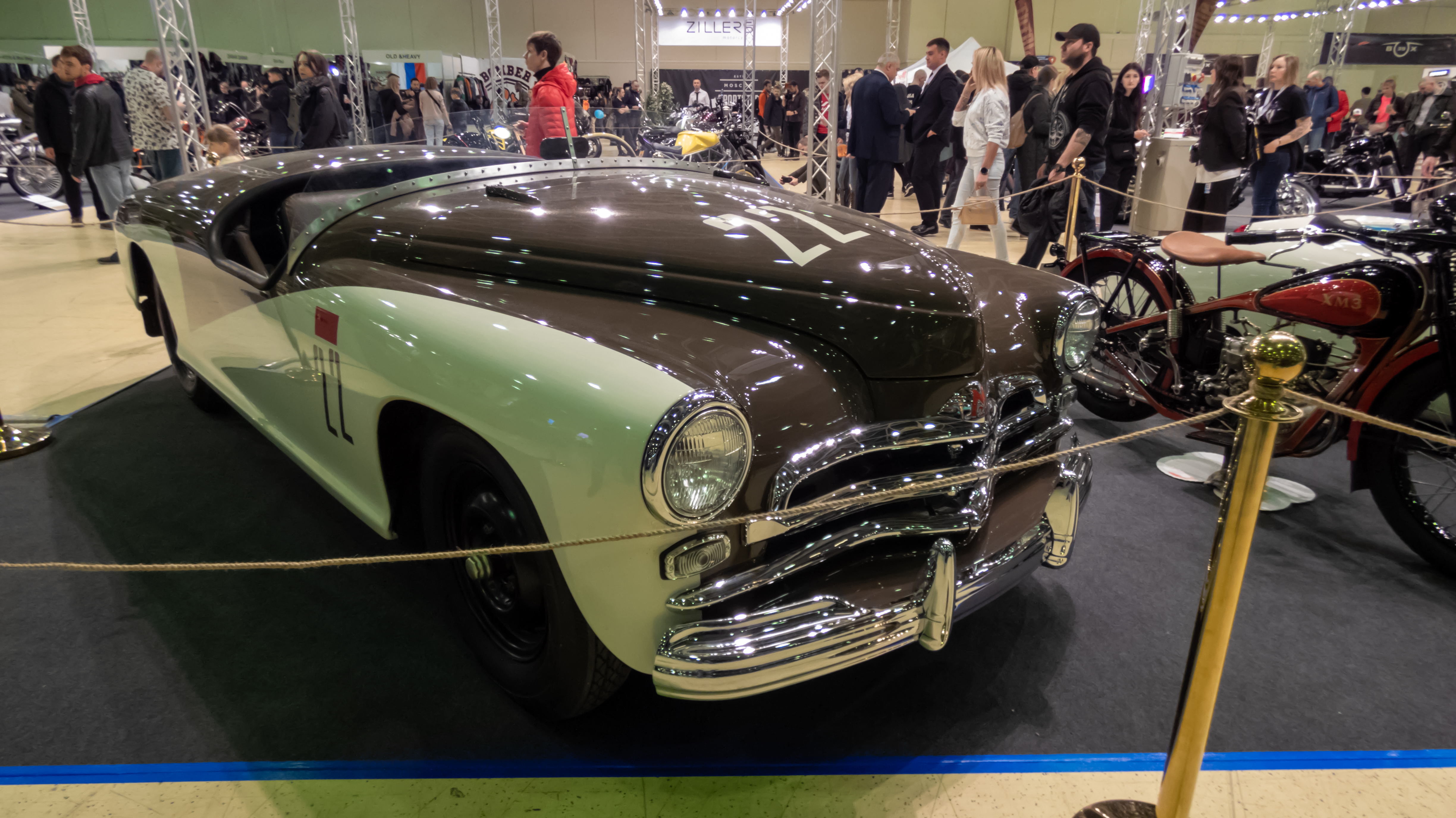|
GAZ-12 ZIM
The ZIM-12 (russian: ЗИМ-12) was a Soviet full-size luxury car produced by the Gorky Automotive Plant (GAZ) from 1950 until 1960. It was the first executive car produced by GAZ and the first one to have the famous leaping gazelle hood ornament. Thompson, p. 68 The car was built to serve high and medium rank Soviet '' nomenklatura'', but was also readily available as a taxi and ambulance. Unlike its successors, ZIM was the only Soviet executive class full-size car that was actually made available for private ownership.''ZIM-12'', "Avtolegendy SSSR" Nr.3 A total of 21,527 examples were built. Development GAZ began the design process for what became the M12 in May 1948, when the Soviet government requested a six-passenger sedan for the niche between the ZIS-110 and the ''Pobeda'', with a deadline of twenty-nine months to produce it. Thompson, p. 66 Due to the lack of time, head designer Andrei Lipgart was given a choice between copying an American product (a Buick) or devel ... [...More Info...] [...Related Items...] OR: [Wikipedia] [Google] [Baidu] |
Nizhny Novgorod
Nizhny Novgorod ( ; rus, links=no, Нижний Новгород, a=Ru-Nizhny Novgorod.ogg, p=ˈnʲiʐnʲɪj ˈnovɡərət ), colloquially shortened to Nizhny, from the 13th to the 17th century Novgorod of the Lower Land, formerly known as Gorky (, ; 1932–1990), is the administrative centre of Nizhny Novgorod Oblast and the Volga Federal District. The city is located at the confluence of the Oka and the Volga rivers in Central Russia, with a population of over 1.2 million residents, up to roughly 1.7 million residents in the urban agglomeration. Nizhny Novgorod is the sixth-largest city in Russia, the second-most populous city on the Volga, as well as the Volga Federal District. It is an important economic, transportation, scientific, educational and cultural center in Russia and the vast Volga-Vyatka economic region, and is the main center of river tourism in Russia. In the historic part of the city there are many universities, theaters, museums and churches. The city ... [...More Info...] [...Related Items...] OR: [Wikipedia] [Google] [Baidu] |
Octane
Octane is a hydrocarbon and an alkane with the chemical formula , and the condensed structural formula . Octane has many structural isomers that differ by the amount and location of branching in the carbon chain. One of these isomers, 2,2,4-trimethylpentane (commonly called iso-octane) is used as one of the standard values in the octane rating scale. Octane is a component of gasoline (petrol). As with all low-molecular-weight hydrocarbons, octane is volatile and very flammable. Use of the term in gasoline "Octane" is colloquially used as a short form of "octane rating," particularly in the expression "high octane". "Octane rating" is an index of a fuel's ability to resist engine knock in engines having different compression ratios, which is a characteristic of octane's branched-chain isomers, especially iso-octane. The octane rating of gasoline is not directly related to the power output of an engine. Using gasoline of a higher octane than an engine is designed for cannot inc ... [...More Info...] [...Related Items...] OR: [Wikipedia] [Google] [Baidu] |
Compression Ratio
The compression ratio is the ratio between the volume of the cylinder and combustion chamber in an internal combustion engine at their maximum and minimum values. A fundamental specification for such engines, it is measured two ways: the static compression ratio, calculated based on the relative volumes of the combustion chamber and the cylinder when the piston is at the bottom of its stroke, and the volume of the combustion chamber when the piston is at the top of its stroke. The dynamic compression ratio is a more advanced calculation which also takes into account gasses entering and exiting the cylinder during the compression phase. Effect and typical ratios A high compression ratio is desirable because it allows an engine to extract more mechanical energy from a given mass of air–fuel mixture due to its higher thermal efficiency. This occurs because internal combustion engines are heat engines, and higher compression ratios permit the same combustion temperature ... [...More Info...] [...Related Items...] OR: [Wikipedia] [Google] [Baidu] |
GAZ-51
The GAZ-51 (nickname ''Gazon'') was a Soviet truck manufactured by GAZ. Its first prototypes were produced before the end of World War II and has been influenced by Studebaker US6. The mass production started in 1946. A 2.5 ton 4×2 standard variant was joined in 1947 by almost identical 2 ton 4×4 GAZ-63. Both variants were powered by 6-cylinder 3485 cc engine. GAZ-63s was manufactured with some changes until 1968 and production of GAZ-51 continued until 2 April 1975. The trucks were also manufactured under the Soviet license in Poland (as the Lublin-51), North Korea North Korea, officially the Democratic People's Republic of Korea (DPRK), is a country in East Asia. It constitutes the northern half of the Korean Peninsula and shares borders with China and Russia to the north, at the Yalu (Amnok) and ... (as the Sungri-58) and China (as the Yuejin NJ-130). Variants *GAZ-51: Standard production version. Produced in 1946–1955. *GAZ-51A: Modernized GAZ-51 ... [...More Info...] [...Related Items...] OR: [Wikipedia] [Google] [Baidu] |
Drivetrain
A drivetrain (also frequently spelled as drive train or sometimes drive-train) is the group of components that deliver mechanical power from the prime mover to the driven components. In automotive engineering, the drivetrain is the components of a motor vehicle that deliver power to the drive wheels. This excludes the engine or motor that generates the power. In marine applications, the drive shaft will drive a propeller, thruster, or waterjet rather than a drive axle, while the actual engine might be similar to an automotive engine. Other machinery, equipment and vehicles may also use a drivetrain to deliver power from the engine(s) to the driven components. In contrast, the powertrain is considered to include both the engine and/or motor(s) as well as the drivetrain. Function The function of the drivetrain is to couple the engine that produces the power to the driving wheels that use this mechanical power to rotate the axle. This connection involves physically linking ... [...More Info...] [...Related Items...] OR: [Wikipedia] [Google] [Baidu] |
Wheelbase
In both road and rail vehicles, the wheelbase is the horizontal distance between the centers of the front and rear wheels. For road vehicles with more than two axles (e.g. some trucks), the wheelbase is the distance between the steering (front) axle and the centerpoint of the driving axle group. In the case of a tri-axle truck, the wheelbase would be the distance between the steering axle and a point midway between the two rear axles. Vehicles The wheelbase of a vehicle equals the distance between its front and rear wheels. At equilibrium, the total torque of the forces acting on a vehicle is zero. Therefore, the wheelbase is related to the force on each pair of tires by the following formula: :F_f = mg :F_r = mg where F_f is the force on the front tires, F_r is the force on the rear tires, L is the wheelbase, d_r is the distance from the center of mass (CM) to the rear wheels, d_f is the distance from the center of mass to the front wheels (d_f + d_r = L), m is the mas ... [...More Info...] [...Related Items...] OR: [Wikipedia] [Google] [Baidu] |
Monocoque
Monocoque ( ), also called structural skin, is a structural system in which loads are supported by an object's external skin, in a manner similar to an egg shell. The word ''monocoque'' is a French term for "single shell". First used for boats, a true monocoque carries both tensile and compressive forces within the skin and can be recognised by the absence of a load-carrying internal frame. Few metal aircraft other than those with milled skins can strictly be regarded as pure monocoques, as they use a metal shell or sheeting reinforced with frames riveted to the skin, but most wooden aircraft are described as monocoques, even though they also incorporate frames. By contrast, a semi-monocoque is a hybrid combining a tensile stressed skin and a compressive structure made up of longerons and ribs or frames. Other semi-monocoques, not to be confused with true monocoques, include vehicle unibodies, which tend to be composites, and inflatable shells or balloon tanks, both of whic ... [...More Info...] [...Related Items...] OR: [Wikipedia] [Google] [Baidu] |
Badge Engineering
In the automotive industry, rebadging is a form of market segmentation used by automobile manufacturers around the world. To allow for product differentiation without designing or engineering a new model or brand (at high cost or risk), a manufacturer creates a distinct automobile by applying a new "badge" or trademark (brand, logo, or manufacturer's name/make/marque) to an existing product line. Rebadging is also known as ''rebranding'' and ''badge engineering''; the latter is an intentionally ironic misnomer, in that little or no actual engineering takes place. The term originated with the practice of replacing an automobile's emblems to create an ostensibly new model sold by a different maker. Changes may be confined to swapping badges and emblems, or may encompass minor styling differences, as with cosmetic changes to headlights, taillights, front and rear fascias and outer body skins. More extreme examples involve differing engines and drivetrains. The objective is " ... [...More Info...] [...Related Items...] OR: [Wikipedia] [Google] [Baidu] |
Andrei Lipgart
Andrei, Andrey or Andrej (in Cyrillic script: Андрэй , Андрей or Андреј) is a form of Andreas/ Ἀνδρέας in Slavic languages and Romanian. People with the name include: *Andrei of Polotsk (–1399), Lithuanian nobleman *Andrei Alexandrescu, Romanian computer programmer *Andrey Amador, Costa Rican cyclist *Andrei Arlovski, Belarusian mixed martial artist * Andrey Arshavin, Russian football player *Andrej Babiš, Czech prime minister *Andrey Belousov (born 1959), Russian politician *Andrey Bolotov, Russian agriculturalist and memoirist *Andrey Borodin, Russian financial expert and businessman *Andrei Broder, Romanian-Israeli American computer scientist and engineer *Andrei Chikatilo, prolific and cannibalistic Russian serial killer and rapist *Andrei Denisov (weightlifter) (born 1963), Israeli Olympic weightlifter *Andrey Ershov, Russian computer scientist *Andrey Esionov, Russian painter *Andrei Glavina, Istro-Romanian writer and politician *Andrei Gromyko ( ... [...More Info...] [...Related Items...] OR: [Wikipedia] [Google] [Baidu] |
GAZ-M20 Pobeda
The GAZ-M20 "Pobeda" (russian: ГАЗ-М20 Победа; ''победа'' means ''victory'') was a passenger car produced in the Soviet Union by GAZ from 1946 until 1958. It was also licensed to the Polish Passenger Automobile Factory and produced as the FSO Warszawa. Although usually known as the GAZ-M20, an original car's designation at that time was just M-20: M for "Molotovets" (the GAZ factory was named after Vyacheslav Molotov). History The first sketches of similar-looking cars were completed by Valentin Brodsky in 1938 and by Vladimir Aryamov in 1940, which revealed a growing tendency towards streamlined car design in the Soviet Union. Aryamov's two-door coupe GAZ-11-80, designed in 1940, greatly resembled the later Pobeda and was in many ways identical to it. However, after the German invasion of 1941 military priorities delayed the work on the new car and the factory was switched to military production. The first Pobeda was developed in the Soviet Union under chief ... [...More Info...] [...Related Items...] OR: [Wikipedia] [Google] [Baidu] |
.jpg)





